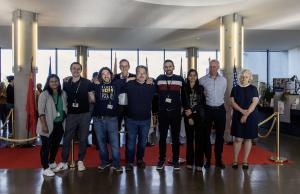ITER Document Management system turns 20
Whatever its nature, every large project generates huge numbers of documents. And when project collaborators operate from different countries, as was the case for ITER in the early 2000s, the challenge is twofold: documents must not only be organized and managed, they must also be made easily accessible to all involved. Today, downloading a technical drawing, a spreadsheet or a detailed report located anywhere in the world can be done, and done fast, with the click of a mouse. But 20 years ago—when ITER was entering the site negotiation phase with technical and scientific teams operating from Naka, Japan, and Münich/Garching, Germany, and political decision-makers based in Brussels, Moscow, Tokyo, Washington and soon Beijing and Seoul¹—it was far from that simple.
Tools already existed: by the late 1990s the email system was well established and the File Transfer Protocol (FTP) allowed the upload and download of large documents. The French Commissariat à l'énergie atomique (CEA), which was very active in promoting the Cadarache site for ITER, had developed a website that, by all accounts, was "pretty good." But for obvious reasons, the international ITER project needed a tool it could call its own.
In the creation of what was to become the ITER Document Management (IDM) system, still central to ITER activities today, two people were to play a key role. One was Hans-Werner Bartels, a physicist involved in ITER nuclear safety since 1994 and who had just been appointed to head the embryonic ITER IT team in Garching ("physicists can do anything," he quips); the other was the Deputy-Project Leader Pietro Barabaschi, then ITER number two under Yasuo Shimomura. Throughout the process of creating and disseminating IDM, both were supported by Carlo Capuano, who Bartels considers "the Leonardo Da Vinci of IT," and Judith Campbell, "who used to run around from office to office" to tirelessly explain the workings of the system in the making.
Bartels remembers precisely the day when the idea of IDM began germinating. "Some time in January 2004, Pietro came into my office to say that we were not strong enough in document management and that we lacked a strategy. Email and FTP were the 'poor man's' file exchange system when the nature of ITER required a globally distributed system."
Drawing from his ten-year experience in ITER nuclear safety where the exchange of large documents between the Members was paramount, Bartels proposed a "web-based application" that could host any kind of document. All files would be made accessible to whoever needed them, which implied, for "serious" international cooperation, an exchange network with a large bandwidth. "Thanks to the strong internet connection of the Max Planck Institute of Plasma Physics in Garching, which hosted ITER at that time, files could be transferred at the rate of 100 MBits per second, which was 10 times what JET had access to and quite good for the day. As a comparison, the network is one thousand times faster today."
IDM was built in record time. A first document was uploaded into the system on 4 October 2004 and from then on IDM was to grow exponentially. Today the system hosts more than one million documents. "This new capability was very well received," says Bartels. "ITER and the fusion community worldwide had been hungry for it."
Twenty years later, IDM is still a formidable asset. "It may not be as user-friendly as we would like it to be and not very modern," acknowledges Bartels who is now back at ITER as head of the Central Integration Division after his former 10-year stint as the head of the IT Section (2004-2012). "IDM is based on the technology of 15 years ago but it is presently undergoing a vast overhaul. We want to make it accessible through small screens, like smartphones, and I expect a quantum leap in search engine efficiency thanks to the introduction of artificial intelligence."
The challenge for IDM is to prepare and be ready for the start of machine operation, "when scientific data will be a hundred times what we are managing today. We'll be going from terabytes to petabytes." In the meantime, the system must transition from document to (meta)data management and establish fluid communication between the different "silos" that are not presently "talking" to each other. Bartels estimates that it will take more than two years to complete the overhaul. IDM will continue doing what it has been good at doing for the past twenty years but in an "integrated manner," with capabilities doped with artificial intelligence and a more modern, user-friendly interface. "This is the ultimate art if you want to have full control of the machine."
¹The United States left the ITER collaboration for five years, between 1998 and 2003. China and Korea joined in 2003, India in 2005.



